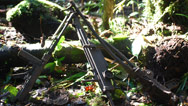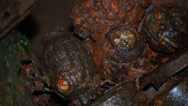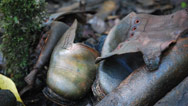Lost WWII battlefield found -– war dead included
An Australian trekker said he has discovered the site of a significant World War II battle in the jungles of Papua New Guinea, complete with the remains of Japanese soldiers right where they fell almost 70 years ago.
Former army Capt. Brian Freeman, an expert on the Kokoda Trail – a 60-mile trek through rugged mountainous country and rainforest of the island – said Monday he was led to the Eora Creek battle site where he found the remains of the soldiers.
The site about half a mile from the village of Eora Creek was believed to be the location of the last major battle that was pivotal in Australia’s campaign against the Japanese in Papau New Guinea.
Although the site was known to local villages, jungles reclaimed it after the battle of Eora Creek. Although locals hunted on the plateau surrounding the site, they avoided the 600-square-meter battle ground because of a belief that spirits of the dead were still present in the "lost battlefield."
What this means is that the site has apparently remained untouched since 1942.
 “On our inaugural trek, we were hoping to find the remnants of a make-shift Japanese hospital and, potentially, relics of guns and ammunition. I never anticipated that we would find war dead,” Freeman said in a statement.
“On our inaugural trek, we were hoping to find the remnants of a make-shift Japanese hospital and, potentially, relics of guns and ammunition. I never anticipated that we would find war dead,” Freeman said in a statement.
Freeman trekked to the site for the first time on April 23.
“It was as if time has stood still. We found ammunition running out in a line from the rifle that was dropped as the Japanese advanced to the rear,” Freeman said.
Freeman said extensive research on battle maps and diaries led them to believe that the Japanese had a medical facility in the area during the Japanese advance and its location had remained a mystery until now.
 The team found kidney-shaped medical dishes at the site, pointing to evidence that the find was indeed the site of a Japanese hospital.
The team found kidney-shaped medical dishes at the site, pointing to evidence that the find was indeed the site of a Japanese hospital.
The presence of large rectangular pits, referred to as rifle pits, also indicated that the location was also a significant Japanese defensive position.
“However, it was the discovery of a Japanese soldier sitting up against a tree, only centimeters from the surface still in his helmet, with his boots nearby that began to tell the human story,” Freeman said.
 The battle of Eora Creek is said to be the single most costly clash of the Kokoda campaign, although different sources cite different casualty figures.
The battle of Eora Creek is said to be the single most costly clash of the Kokoda campaign, although different sources cite different casualty figures.
Freeman's group says 79 Australians died and 145 were wounded, while the Australian War Memorial website says 99 were killed and 192 wounded.
Freeman said they are working with respective governments to repatriate the fallen solders and preserve the site in its “current pristine condition." Until then, no groups will be permitted to trek the site.
Former army Capt. Brian Freeman, an expert on the Kokoda Trail – a 60-mile trek through rugged mountainous country and rainforest of the island – said Monday he was led to the Eora Creek battle site where he found the remains of the soldiers.
The site about half a mile from the village of Eora Creek was believed to be the location of the last major battle that was pivotal in Australia’s campaign against the Japanese in Papau New Guinea.
Although the site was known to local villages, jungles reclaimed it after the battle of Eora Creek. Although locals hunted on the plateau surrounding the site, they avoided the 600-square-meter battle ground because of a belief that spirits of the dead were still present in the "lost battlefield."
What this means is that the site has apparently remained untouched since 1942.
 “On our inaugural trek, we were hoping to find the remnants of a make-shift Japanese hospital and, potentially, relics of guns and ammunition. I never anticipated that we would find war dead,” Freeman said in a statement.
“On our inaugural trek, we were hoping to find the remnants of a make-shift Japanese hospital and, potentially, relics of guns and ammunition. I never anticipated that we would find war dead,” Freeman said in a statement.Freeman trekked to the site for the first time on April 23.
“It was as if time has stood still. We found ammunition running out in a line from the rifle that was dropped as the Japanese advanced to the rear,” Freeman said.
Freeman said extensive research on battle maps and diaries led them to believe that the Japanese had a medical facility in the area during the Japanese advance and its location had remained a mystery until now.
 The team found kidney-shaped medical dishes at the site, pointing to evidence that the find was indeed the site of a Japanese hospital.
The team found kidney-shaped medical dishes at the site, pointing to evidence that the find was indeed the site of a Japanese hospital.The presence of large rectangular pits, referred to as rifle pits, also indicated that the location was also a significant Japanese defensive position.
“However, it was the discovery of a Japanese soldier sitting up against a tree, only centimeters from the surface still in his helmet, with his boots nearby that began to tell the human story,” Freeman said.
 The battle of Eora Creek is said to be the single most costly clash of the Kokoda campaign, although different sources cite different casualty figures.
The battle of Eora Creek is said to be the single most costly clash of the Kokoda campaign, although different sources cite different casualty figures.Freeman's group says 79 Australians died and 145 were wounded, while the Australian War Memorial website says 99 were killed and 192 wounded.
Freeman said they are working with respective governments to repatriate the fallen solders and preserve the site in its “current pristine condition." Until then, no groups will be permitted to trek the site.

No comments:
Post a Comment